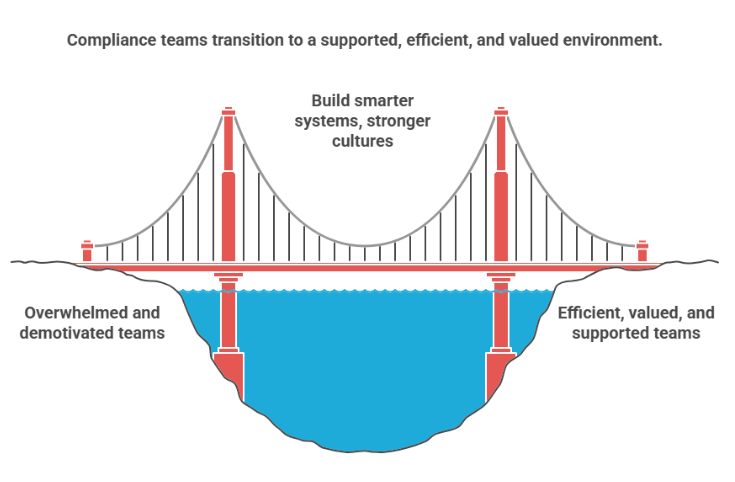Compliance Fatigue Is Real: Here’s How to Stay Ahead Without Burning Out
- AMS Team

- Jul 30
- 3 min read
The Burnout Behind the Rulebook
Compliance is no longer just a background task. It sits at the heart of your business operations.
Every year, new regulations, evolving technology, and rising expectations add to the workload. Teams must keep pace with shifting rules while managing daily responsibilities.
But there’s a human cost. Burnout, fatigue, and disengagement are growing problems for compliance professionals. The constant pressure can leave your team feeling overwhelmed and undervalued.
This blog shows you how to build smarter systems and stronger cultures.
You’ll learn how to protect your business and your people without burning out your compliance team.
What Is Compliance Fatigue?
Compliance fatigue is the emotional exhaustion that comes from dealing with constant regulatory demands.
It’s more than just stress. Over time, it wears down your motivation, morale, and energy.
You might notice these warning signs:
Avoiding compliance tasks or putting them off
Making more mistakes or missing important policies
Feeling cynical about your company’s values and procedures
When these signs appear, it’s a signal that your team needs support and smarter systems to keep compliance on track.
The Root Causes of Compliance Burnout
Several factors drive compliance burnout in today’s workplaces.
Overload of Regulatory Change
New rules arrive nonstop ESG, AI, cybersecurity, Consumer Duty, and more. Teams scramble to keep up.
Responsibility Without Authority
Compliance officers are expected to manage risk but often lack the power to make key decisions.
Manual, Outdated Processes
Many teams still rely on paper trails, scattered data, and repeated manual reviews. This slows work and increases frustration.
Cultural Disconnect
Ethics and compliance are sometimes treated as public relations, not real action. This disconnect erodes trust and engagement.
Lack of Recognition or Impact
Ethical work often goes unseen until something breaks. This lack of visibility can make the work feel thankless.
Understanding these root causes is the first step to preventing burnout and building a healthier compliance culture.

The Risk of Ignoring Fatigue
Ignoring compliance fatigue comes with real consequences.
Human error and non-compliance become more common.
Burnout leads to higher turnover and talent gaps.
Low morale encourages shortcuts, silence, and misreporting.
Trust breaks down, both inside and outside your organization.
Legal, financial, and reputational risks increase.
Addressing fatigue early helps protect your team and your business from these costly outcomes.
10 Practical Strategies to Stay Ahead Without Burning Out
Build Compliance into the Flow of Work
Use technology that makes compliance automatic. Embed checks into daily processes so they happen naturally.
Simplify, Streamline, Automate
Reduce unnecessary steps. Automate monitoring, tracking, and alerts to cut down on repetitive tasks.
Create a Culture of Shared Responsibility
Treat compliance as everyone’s job, not just the risk teams. Train all employees so they understand their role.
Keep Training Ongoing and Human
Move beyond dry legal briefings. Use real scenarios and stories to make training relevant and memorable.
Encourage Feedback and Two-Way Communication
Make it easy for your team to share concerns or spot gaps. Listen and improve systems based on their input.
Refresh and Rationalise Your Policies
Review policies regularly. Use clear language and explain the reasons behind each rule.
Secure Leadership Visibility and Support
Leaders need to show visible commitment. Their buy-in sets the tone for the entire organization.
Recognise Ethical Wins, Not Just Failures
Celebrate principled decisions. Make integrity part of regular performance conversations.
Leverage External Expertise When Needed
Bring in outside advisors for fresh perspective and clarity. Don’t let fatigue turn into tunnel vision.
Protect the Protectors
Support the mental health of your compliance and risk teams. Encourage boundaries, regular breaks, and team support systems.
These strategies help you build a sustainable compliance culture that protects both your business and your people.

Compliance Without Burnout: A Smarter Way Forward!
Compliance is here to stay. Fatigue doesn’t have to be.
When you modernize your tools, share responsibility, and support your team, you protect both your business and your people.
Stay compliant. Stay resilient. Stay human.
Need help building a sustainable compliance process that works?
AMS Admin Services supports firms with streamlined systems, trained offshore teams, and ongoing risk oversight so your people stay focused, not fatigued.
Let’s talk!




Comments